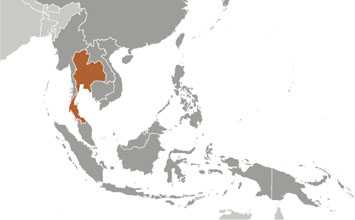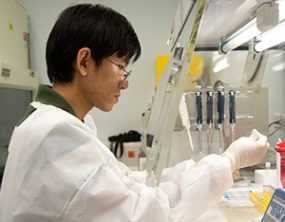
CDC recently marked 30 years of collaboration with the Thailand Ministry of Public Health. This collaboration has produced new disease prevention and intervention strategies that have had significant global impacts. From the establishment in 1980 of the Field Epidemiology Training Program to current efforts to meet the growing challenges of drug-resistant malaria, TB, HIV, emerging infectious diseases, border health, and noncommunicable diseases, CDC’s work with Thailand protects Thais and Americans from major health threats.

Staff
CDC office (physical presence)
17 Assignees
177 Locally Employed

Thailand at a Glance
Population: 69,892,000
Per capita income: $7,640
Life expectancy at birth women/men: 77/70 yrs
Infant mortality rate: 12/1000 live births
Population Reference Bureau World Population Data Sheet, 2011

Top 10 Causes of Death
Source: GBD Compare, 2010
- Cancer 19%
- Ischemic Heart Disease 12%
- Stroke 10%
- Lower Respiratory Infections 9%
- HIV 4%
- Chronic Obstructive Pulmonary Disease 4%
- Diabetes 4%
- Road Injuries 4%
- Chronic Kidney Disease 2%
- Cirrhosis 2%
What CDC Is Doing
Impact in Thailand
- Thailand implemented a flu vaccine policy for the elderly and adults with underlying disease based on data CDC helped provide.
- Built local epidemiologic capacity that influenced national policy to increase the number of people living with HIV that are eligible for treatment by 20%.
- Identified first reported cases of Bartonella endocarditis and Coxiella burnetii (Q fever) endocarditis in Thailand, leading to CDC-supported efforts to build national laboratory capacity these two important zoonotic pathogens.
HIV/AIDS

To prevent new HIV infections and improve the quality of life of people living with HIV, CDC works closely with the Thai MoPH to develop model approaches and expand prevention, surveillance, and care and treatment of HIV. This technical assistance helps the Thai MoPH improve laboratory infrastructure, strategic information, HIV care quality, interventions for men who have sex with men (MSM), and care and treatment of children infected with HIV. CDC Thailand also serves as the Asia Regional Office (ARO), supporting Laos and providing technical assistance to other countries in the region, often including Thai government partners in the collaborations. CDC works to improve HIV programs by building country capacities needed to mount and sustain an effective national HIV response. These activities support a data-driven, evidence-based approach that is tailored to the unique characteristics of the local epidemic for maximum health impact and the most efficient use of resources.CDC also works with the Thai MoPH to conduct studies of HIV incidence and risk behaviors and evaluates biomedical and behavioral interventions to prevent HIV infection. Current research activities focus on people who inject drugs MSM. CDC also helped establish a clinic for MSM in Bangkok that provides a model for the integration of HIV research and prevention services.
Non-Communicable Diseases (NCDs)
CDC is working with the Thai MoPH to help address NCDs. One key project involves working with the Thailand Behavioral Risk Factor Surveillance System (BRFSS) team on building Thailand’s capacity for NCD surveillance. This involves instruction on population sampling and conducting a demonstration project in Sukothai Province on surveillance data on hypertension. Another project aims to better understand salt and fat consumption in Thailand and to develop strategies to address this problem (e.g., food reformulations, education campaigns).
Immigrant, Refugee, and Migrant Health
CDC aims to stop the spread of infectious diseases among immigrants, refugees, international travelers, and other mobile populations that cross international borders. This program oversees the content and quality of medical screening of U.S.-bound immigrants and refugees and assists Thailand in improving the health of refugees and migrants within Thailand’s borders. With approximately half of the 75,000 refugees legally admitted into the U.S. arriving from Asia, this regional program supports disease surveillance among the U.S.-bound populations and helps prevent the introduction of infectious diseases into the U.S.
Learn more about our work with immigrants, refugees, and migrants in Thailand.
Tuberculosis (TB)

Thailand is one of the 22 countries designated as high TB-burden by the World Health Organization (WHO). To improve TB prevention, diagnosis, treatment, and program management, CDC works with the Thai MoPH providing assistance to WHO and other countries throughout the region. A recent multi-country study led to a simple clinical algorithm that health personnel can use to help detect TB in HIV-positive persons. CDC is currently working with Thailand, Cambodia, and Vietnam to assess the impact of new diagnostic techniques and approaches to prevent the spread of TB in health care settings.
Global Disease Detection (GDD)
Working with the Thailand MoPH, Ministry of Agriculture and Cooperatives, and other partners, GDD addresses the threat of emerging infectious diseases in Thailand and South East Asia by responding to public health emergencies; strengthening laboratory capacity and biosafety; implementing multidisciplinary approaches to disease detection and response; and modeling laboratory-based surveillance for high-burden diseases like pneumonia, TB, and invasive bacterial infections. GDD has supported Thailand’s response to MERS-CoV (Middle East Respiratory Syndrome Coronavirus) through human surveillance and the regional response to influenza A (H7N9) through enhanced animal surveillance. As one of ten Regional GDD Centers around the world, GDD-Thailand works with WHO and ministries of health to strengthen core capacity requirements (e.g., laboratory, surveillance, response and human resources) for implementation of the International Health Regulations.
Influenza Program
Knowledge of the epidemiology of influenza in the tropics has increased substantially because of CDC’s collaborative work in Thailand. The work that CDC and Thai MoPH collaborated on led to the introduction of a seasonal influenza vaccine into Thailand’s National Vaccination Program. During the 2009 H1N1 influenza pandemic, collaborative projects provided real-time data to help track the epidemic and assess risks. Thailand’s aggressive changes in biosafety, community education, and prompt detection have eliminated outbreaks of avian influenza in the last several years. CDC also worked with WHO to create a regional stockpile of personal protective equipment and medicines for emergency outbreak response.
Malaria Control
CDC’s support for malaria control in the Greater Mekong Sub-region began in 2008 in collaboration with USAID. This successful collaboration was expanded as part of The President’s Malaria Initiative (PMI), which in 2011 expanded its activities in the region in response to the problem of artemisinin-resistant Plasmodium falciparum malaria. The PMI regional strategy emphasizes malaria prevention and control in areas of known or emerging artemisinin resistance, supporting well-functioning antimalarial drug resistance surveillance networks, and building capacity to monitor the quality of antimalarial drugs as a means of preventing the introduction and dissemination of sub-standard and counterfeit drugs. PMI carefully manages interventions for maximal programmatic impact, particularly focusing in austere border areas with transient mobile populations and poor health care infrastructure.
Global Health Security Agenda
CDC is working with Thailand to improve their ability to prevent, detect and respond to infectious disease threats. This work helps meet the U.S. commitment to assist at least 31 countries in reaching the targets outlined in the Global Health Security Agenda. CDC’s extensive global health presence and experience are critical to achieving these targets.
Resources and Links
General
- US Embassy to Thailand
- CIA World Factbook: Thailand
- Global School-based Student Health Survey (GSHS): Thailand
- Immigrant, Refugee and Migrant Health
- Global Reproductive Health Activities in Asia
Travel
- Health Information for Travelers to Thailand
- U.S. Department of State International Travel Information: Thailand
Diseases
Infectious Diseases
- CDC International Influenza Program in Thailand
- Parasites: Schistosomiasis in Thailand
- Highly Pathogenic Avian Influenza A (H5N1) in Birds and Other Animals
- Melioidosis Disease in South East Asia
- Parasites – Opisthorchis Infection in Thailand
Yellow Fever and Malaria
- Yellow Fever and Malaria Information: Thailand
- CDC Global Malaria website
- Malaria Information and Prophylaxis: Thailand
- Choosing a Drug to Prevent Malaria
HIV/AIDS
- CDC’s HIV/AIDS Activities in Thailand
- CDC’s Global Health Programs: Global HIV/AIDS
- President’s Emergency Plan for AIDS Relief (PEPFAR)
Measles
- CDC Global Measles website
- Measles Update(https://www.cdc.gov/travel/notices/outbreak-notice/measles.htm)
Tuberculosis
Success Stories
- Page last reviewed: September 13, 2017
- Page last updated: September 13, 2017
- Content source:
Global Health
Notice: Linking to a non-federal site does not constitute an endorsement by HHS, CDC or any of its employees of the sponsors or the information and products presented on the site.



 ShareCompartir
ShareCompartir
